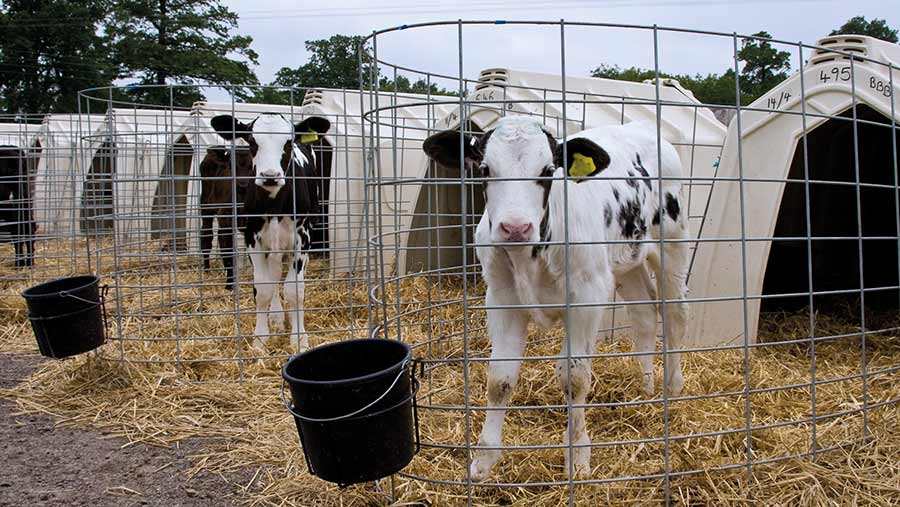How to prevent and treat scours in calves
 © Tim Scrivener
© Tim Scrivener While disease can be a trigger for calf scours, so can early calf nutrition, with the concentration of milk replacer having a direct effect on gastrointestinal environment.
Osmolality is a measure of the concentration of sugar and mineral particles per kilogram of solution.
The normal osmolality of cows’ blood and milk is 300 milliosmoles (mOsm)/kg. Feeding milk replacers at too high a concentration upsets this balance, causing scouring and bloat.
Farmers Weekly asks Oliver Tilling, farm vet at Shepton Vets, how to prevent and treat scouring.
See also: Complete guide to feeding newborn heifers
What is the impact of scours?
Calves affected with scours are twice as likely to develop pneumonia. Growth rates are also affected. According to a Luke O’Grady paper in 2004, calves with neonatal scour lost 26.5kg – primarily in the first 180 days. This equated to an average reduction of 0.15kg/day.
MSD Animal Health calculates the cost of a scouring calf exceeds £44, not including the labour involved in care. Costs escalate with retreatments, a reduction in production in first lactation and an increase of up to 30 days in age at first calving.
How does the osmolality of milk play a role?
Osmolality relates to the concentration of particles, including sugars like lactose and minerals like sodium, magnesium and chloride. The mixing rate of milk replacers, therefore, dictates total solids and osmolality levels.
Cow’s milk has a higher fat content than lactose, whereas milk replacers tend to have a higher lactose level over fat content.
Lactose content affects the osmolality so that is why we see these elevated levels of osmolality in milk replacers.
The highest milk replacers sit at 600mOsm/kg but range from 400-600mOsm/kg. Having lactose in milk replacers isn’t bad, it’s the amount.
Ideally, the main energy supply should be coming from a quality, digestible fat source, which will offer a good fatty acid profile and help keep osmolality at the lower end of the range, closer to cow’s milk.
Typically, producers should mix milk powder at 125-150g/litre of water to provide 12.5-15% of total solids. This is similar to whole milk at 12.5%. Increasing concentration raises this level further, which can delay abomasal emptying and cause bloat, inflammation and scours.
A good-quality milk replacer will provide the calf with adequate nutrition to reach target daily liveweight gains (DLWG) of 0.75-0.85g/day and support immune development.
How can you reduce the risk of scours?
Split the calves’ total daily requirement of milk feed equally into at least two feeds/day.
Often, farmers will increase or decrease mixing rates in response to a performance or environmental challenge.
To reduce the risk of scour or bloat from higher osmolality, mixing rates should not exceed 170g/litre and free access to fresh water must be available to allow the calf to quench its thirst and dilute sugars and minerals in the body.
Consistency is key. Fluctuations in milk replacer osmolality, quantity, temperature and timing of feeds are stressors for calves, and can cause or exacerbate health problems.
Instead of increasing the concentration, it may be more beneficial to increase the total volume (litres) given or number of feeds/day, which can be divided over more feeds if required. Additionally, in colder conditions, calf jackets and extra bedding can be used to reduce the body’s energy demands.
Why is it so important to provide calves with fresh water?
Calves cannot receive all the water they require from milk.
Water is essential for hydration and rumen development. Pre-weaned calves up to one month old require five to eight litres of fresh water/day, and then six to 10 litres/day up to two months of age.
Numerous studies show the importance of offering fresh water from day one.
In one study, five-month-old calves that received free access to water from day one were 13kg heavier than calves that had water withheld until 17 days old.
How should you treat scours?
Scours can also be caused by infections, so use veterinary testing to firstly establish the cause.
Scouring calves suffer large faecal electrolyte and water losses, becoming dehydrated very quickly. They also tend to suffer from metabolic acidosis – a fall in blood pH – from faecal bicarbonate losses, fermentation of nutrients in the gut and ion imbalances in the blood.
Any calf that is scouring – or showing symptoms of pneumonia – should receive oral electrolyte therapy. These must be given quickly and correctly to minimise gut damage and avoid death.
However, oral electrolytes have high osmolality levels – 400-600mOsm/kg – so it is important they are fed correctly to avoid worsening the condition.
The recommended composition is:
- Sodium: 90-130 millimoles (mmol)/litre
- Chloride: 40-80 mmol/litre
- Potassium: 10-30 mmol/litre
- Glucose: variable
- Alkalising agent (bicarbonate/bicarbonate precursors): 60-80mmol/litre.
Sodium and glucose facilitate water absorption and replenish losses from scour while bicarbonate increases blood pH and correct metabolic acidosis.
Advice on administering oral electrolytes
- Use a teat bucket or a bottle. If the calf will not take it, then tube feed.
- Do not withdraw milk feeds – it will slow the calf’s recovery as the electrolytes will not provide enough energy on their own.
- Follow advised milk replacer mixing rates carefully and do not add electrolytes – particularly in powder form – to milk; they should always be mixed with water. Feeding electrolytes in milk or milk replacer can cause high levels of osmolality that burn the calf’s gastrointestinal tract.
- Feed a minimum of two electrolyte mixes/day, alternating with milk feeds. Leave at least two hours between each milk and electrolyte feed.
